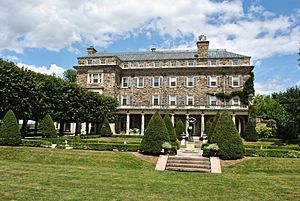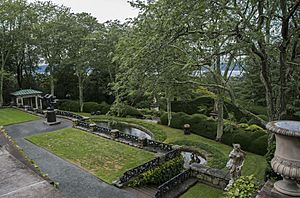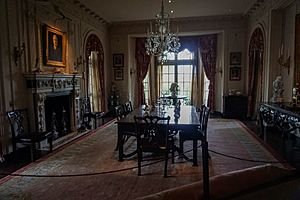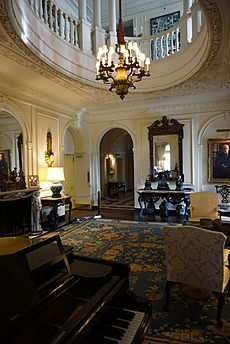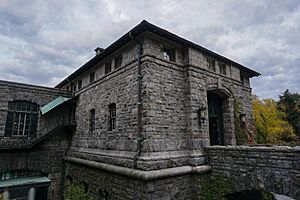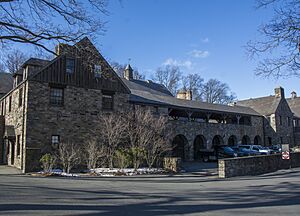Kykuit facts for kids
|
John D. Rockefeller Estate (Kykuit)
|
|
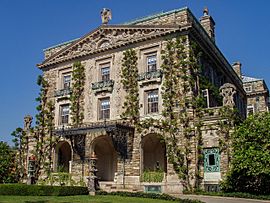
Front facade, designed by William Welles Bosworth
|
|
| Location | 200 Lake Road, Pocantico Hills, New York |
|---|---|
| Area | 3,400 acres (1,380 ha) |
| Built | 1913 |
| Architect | Delano & Aldrich William Welles Bosworth (landscape and renovations) |
| Architectural style | Colonial Revival |
| NRHP reference No. | 76001290 |
Quick facts for kids Significant dates |
|
| Added to NRHP | May 11, 1976 |
| Designated NHL | May 11, 1976 |
Kykuit (pronounced KY-kət) is also known as the John D. Rockefeller Estate. It's a huge 40-room historic house in Pocantico Hills, New York. This area is about 25 miles north of New York City.
The house was built for John D. Rockefeller, a very rich oil businessman. His son, John D. Rockefeller Jr., helped plan it. Later, his grandson, Nelson Rockefeller, who was a governor and vice president, added many amazing artworks. Four generations of the Rockefeller family lived here.
Today, Kykuit is a National Historic Landmark. It is owned by the National Trust for Historic Preservation. You can take tours of the house through Historic Hudson Valley.
The name Kykuit comes from a Dutch word meaning "lookout." The house is on the highest point in Pocantico Hills. It has amazing views of the Hudson River and even the New York City skyline far away.
Contents
Kykuit's History: A Family Home
John D. Rockefeller started buying land in this area in 1893. His brother, William, had already moved into a large mansion nearby. Rockefeller and his family first lived in a house called Parsons-Wentworth House. They spent winters and parts of summers there.
Sadly, the Parsons-Wentworth House burned down in 1902. The family then moved into the Kent House temporarily. John D. Rockefeller had been worried about the old electrical wiring in the burned house.
The first design for Kykuit was a three-story stone mansion. Architects Chester Holmes Aldrich and William Adams Delano created it. Abby Aldrich Rockefeller, John D. Rockefeller Jr.'s wife, helped with the interior design.
The house took six years to build. Before anyone moved in, it was changed quite a bit. It became the four-story Georgian-style house you see today. It was finished in 1913. The house has two basement levels with secret passages and tunnels. Inside, you can see beautiful Chinese and European art. There are also fancy furnishings and art from the 1900s.
Kykuit became a National Historic Landmark in 1976. In 1979, Nelson Rockefeller left his share of the estate to the National Trust for Historic Preservation. Now, Historic Hudson Valley offers tours to the public.
In 1995, Kykuit was updated. New changes made it easier for groups to tour the first floor and art gallery. Guest rooms were also added on the upper floors.
Exploring Kykuit's Amazing Gardens
At first, a company called Olmsted Brothers worked on the gardens. But John D. Rockefeller Senior wasn't happy with their work. So, he took over the design himself! He even moved whole grown trees and planned scenic roads.
In 1906, architect William Welles Bosworth took over the garden design. He created the terraces and gardens with fountains, pavilions, and classical statues. These gardens are in the Beaux-Arts style. They are considered some of Bosworth's best work in the United States. They offer wonderful views of the Hudson River.
Bosworth's original gardens are still there today. The plants are carefully replaced over time. The terraced gardens include a Morning Garden, a Grand Staircase, and a Japanese Garden. There's also an Italian Garden, a Japanese-style brook, and a Japanese Tea-house. You can also see a large Oceanus fountain, a Temple of Aphrodite, and a rose garden.
Art Treasures at Kykuit
The estate is filled with many artworks. These pieces show what the past residents liked. Governor Nelson Rockefeller collected many artworks from the 1900s. He especially liked abstract art from the 1950s to the 1970s.
Nelson Rockefeller turned empty basement passages into a large private art gallery. It has paintings by famous artists like Picasso, Chagall, and Warhol. Chagall and Warhol even visited the estate!
Between 1935 and the late 1970s, over 120 modern sculptures were added to the gardens. These include works by artists such as Pablo Picasso, Constantin Brâncuși, Alexander Calder, and Henry Moore.
Visiting Kykuit: What to Expect
The main part of Kykuit opened for tours in 1994. The Rockefeller Brothers Fund manages this historic area.
Historic Hudson Valley runs the public tours. This organization was started in 1951 by John D. Rockefeller Jr.. Its goal is to celebrate the history and beauty of the Hudson Valley. Shuttle vans take visitors from a visitor center in Sleepy Hollow, New York.
The Big Rockefeller Estate: Pocantico Hills
The larger estate, known as Pocantico or Pocantico Hills, covers about 3,400 acres. For much of the 1900s, it had its own staff. This included security guards, gardeners, and farm workers. It even had its own farms and food supplies.
The estate has a nine-hole golf course. At one time, it had 75 houses and 70 private roads. Most of these were designed by John D. Rockefeller Sr. and his son. People used to joke that "It's what God would have built, if only He had the money."
In 1901, John D. Rockefeller Sr. hired golf course designer Willie Dunn. Dunn built a golf course on the grounds.
In 1946, two of John D. Rockefeller Jr.'s sons offered their homes as headquarters for the new United Nations. But their father said no because the locations were too far from Manhattan. Instead, he asked his son Nelson to buy land in New York City. This land was then given for the UN Headquarters.
Many important guests have visited the estate. These include American Presidents like Lyndon B. Johnson and Ronald Reagan. Other famous visitors include Nelson Mandela, the Shah of Iran, and King Hussein of Jordan.
As of 2003, about 10 Rockefeller families lived on the estate. Much of the land has been given to New York State over the years. This includes the Rockefeller State Park Preserve. It is open to the public for horseback riding, biking, and jogging. Bill Clinton, who lives nearby, often runs in the State Park.
Family Homes on the Estate
Some family homes are within the park area:
- "Hawes House," where Nelson Rockefeller lived.
- "Kent House," where Laurance Rockefeller lived.
Other family homes are just outside the park:
- "Fieldwood Farm," home of John D. Rockefeller III.
- "Hudson Pines," home of David Rockefeller. This house was first built for his sister, Abby.
- "Hunting Lodge," a second home for Nelson Rockefeller.
- "Rockwood Hall," which belonged to John D. Rockefeller Sr.'s brother, William. It is now part of the Rockefeller State Park Preserve.
Cool Buildings and Places
- The Pocantico Conference Center of the Rockefeller Brothers Fund (RBF) is in the park. It hosts regular meetings.
- This building was originally a "Coach Barn." It was finished in 1914 and is three times bigger than the Kykuit mansion. It still holds a collection of horse-drawn carriages. It also has 12 old family cars, showing how car design changed over time.
- In 1994, the lower floor was turned into a modern meeting place. It's used for the Fund's conferences and for other non-profit groups.
- The "Playhouse" is a family gathering spot in the park. The family holds meetings here twice a year.
- This large French Norman-style building was finished in 1927. It is also three times the size of the Kykuit mansion. It's next to the golf course, an outdoor pool, and tennis courts. Inside, it has an indoor pool, a basketball gym, a squash court, a billiard room, and a bowling alley. It also has dining rooms and a huge reception room.
- The Orangerie, which holds citrus plants, is like the one at the Palace of Versailles.
- The Breuer Guest House is a modern house. It was shown at a museum, then taken apart and rebuilt at the estate.
- The Underground Bomb Shelter.
- The Stone Barns Center for Food & Agriculture is outside the park. It was opened in 2004 by David Rockefeller. It's a farm and education center on 32 acres. It sells organic food to a nearby restaurant and local businesses.
- The Rockefeller Archive Center is a huge three-story underground bunker. It holds over 150 years of Rockefeller family papers and other collections. Researchers can visit it to learn about the family's history.
The Rockefeller family also had a big impact on the nearby village of Pocantico Hills. The Union Church of Pocantico Hills was built by the family. It has beautiful stained-glass windows by famous artists like Matisse and Chagall. The family also helped build the local Pocantico Hills School.
See Also


